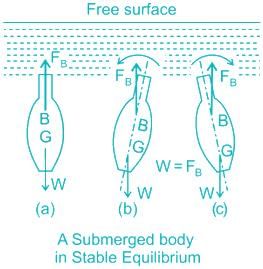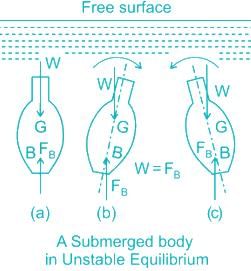SSC Exam > SSC Questions > A submerged body will be in stable equilibri...
Start Learning for Free
A submerged body will be in stable equilibrium if the centre of gravity is
- a)Below the centre of buoyancy
- b)Above the centre of buoyancy
- c)Coinciding with the centre of buoyancy
- d)None of the above
Correct answer is option 'A'. Can you explain this answer?
Most Upvoted Answer
A submerged body will be in stable equilibrium if the centre of gravi...
Stability of unconstrained Submerged Bodies in Fluid


The equilibrium of a body submerged in a liquid requires that the weight of the body acting through its centre of gravity should be collinear with an equal hydrostatic lift acting through the centre of buoyancy.
- Stable Equilibrium: If the body returns to its original position by retaining the originally vertical axis as vertical
- Unstable Equilibrium: If the body does not return to its original position but moves further from it
- Neutral Equilibrium: If the body neither returns to its original position nor increases its displacement further, it will simply adopt its new position
The relative position of the centre of gravity (G) and centre of buoyancy (B) of a body determines the stability of a submerged body.
- Stable Equilibrium: B is above G

- Unstable Equilibrium: B is below G

- Neutral Equilibrium: B coincides with G

Free Test
FREE
| Start Free Test |
Community Answer
A submerged body will be in stable equilibrium if the centre of gravi...
Stable Equilibrium of a Submerged Body
To understand why the correct answer is option 'A', let's first define the terms involved:
1. Centre of Gravity (CG): It is the point through which the total weight of an object can be considered to act. It is the point where the entire weight of the object is concentrated.
2. Centre of Buoyancy (CB): It is the point at which the buoyant force, or the upward force exerted on a submerged object by the surrounding fluid, can be considered to act. It is the point where the entire buoyant force is concentrated.
Now, let's discuss the equilibrium conditions for a submerged body:
- When a body is fully or partially submerged in a fluid, it experiences an upward force called the buoyant force. The magnitude of the buoyant force is equal to the weight of the fluid displaced by the body.
- For a body to be in equilibrium, the forces acting on it must be balanced. In the case of a submerged body, this means that the weight of the body and the buoyant force must be equal in magnitude and opposite in direction.
Why is Option 'A' Correct?
The correct answer is option 'A' because a submerged body will be in stable equilibrium when the centre of gravity is below the centre of buoyancy. Here's why:
- When the centre of gravity is below the centre of buoyancy, the body tends to return to its original position if it is slightly displaced.
- If the body is tilted or displaced from its equilibrium position, the centre of gravity and the centre of buoyancy will no longer be aligned vertically. As a result, a torque or turning moment is produced.
- This torque will cause a restoring force that acts to bring the body back to its original position. The body will oscillate back and forth around its equilibrium position until it comes to rest.
- This stable equilibrium occurs because the weight of the body acts downwards from the centre of gravity, while the buoyant force acts upwards from the centre of buoyancy. The weight and the buoyant force create a couple that tends to restore the body to its original position.
Therefore, option 'A' is the correct answer for a submerged body to be in stable equilibrium.
To understand why the correct answer is option 'A', let's first define the terms involved:
1. Centre of Gravity (CG): It is the point through which the total weight of an object can be considered to act. It is the point where the entire weight of the object is concentrated.
2. Centre of Buoyancy (CB): It is the point at which the buoyant force, or the upward force exerted on a submerged object by the surrounding fluid, can be considered to act. It is the point where the entire buoyant force is concentrated.
Now, let's discuss the equilibrium conditions for a submerged body:
- When a body is fully or partially submerged in a fluid, it experiences an upward force called the buoyant force. The magnitude of the buoyant force is equal to the weight of the fluid displaced by the body.
- For a body to be in equilibrium, the forces acting on it must be balanced. In the case of a submerged body, this means that the weight of the body and the buoyant force must be equal in magnitude and opposite in direction.
Why is Option 'A' Correct?
The correct answer is option 'A' because a submerged body will be in stable equilibrium when the centre of gravity is below the centre of buoyancy. Here's why:
- When the centre of gravity is below the centre of buoyancy, the body tends to return to its original position if it is slightly displaced.
- If the body is tilted or displaced from its equilibrium position, the centre of gravity and the centre of buoyancy will no longer be aligned vertically. As a result, a torque or turning moment is produced.
- This torque will cause a restoring force that acts to bring the body back to its original position. The body will oscillate back and forth around its equilibrium position until it comes to rest.
- This stable equilibrium occurs because the weight of the body acts downwards from the centre of gravity, while the buoyant force acts upwards from the centre of buoyancy. The weight and the buoyant force create a couple that tends to restore the body to its original position.
Therefore, option 'A' is the correct answer for a submerged body to be in stable equilibrium.

|
Explore Courses for SSC exam
|

|
Similar SSC Doubts
A submerged body will be in stable equilibrium if the centre of gravity isa)Below the centre of buoyancyb)Above the centre of buoyancyc)Coinciding with the centre of buoyancyd)None of the aboveCorrect answer is option 'A'. Can you explain this answer?
Question Description
A submerged body will be in stable equilibrium if the centre of gravity isa)Below the centre of buoyancyb)Above the centre of buoyancyc)Coinciding with the centre of buoyancyd)None of the aboveCorrect answer is option 'A'. Can you explain this answer? for SSC 2025 is part of SSC preparation. The Question and answers have been prepared according to the SSC exam syllabus. Information about A submerged body will be in stable equilibrium if the centre of gravity isa)Below the centre of buoyancyb)Above the centre of buoyancyc)Coinciding with the centre of buoyancyd)None of the aboveCorrect answer is option 'A'. Can you explain this answer? covers all topics & solutions for SSC 2025 Exam. Find important definitions, questions, meanings, examples, exercises and tests below for A submerged body will be in stable equilibrium if the centre of gravity isa)Below the centre of buoyancyb)Above the centre of buoyancyc)Coinciding with the centre of buoyancyd)None of the aboveCorrect answer is option 'A'. Can you explain this answer?.
A submerged body will be in stable equilibrium if the centre of gravity isa)Below the centre of buoyancyb)Above the centre of buoyancyc)Coinciding with the centre of buoyancyd)None of the aboveCorrect answer is option 'A'. Can you explain this answer? for SSC 2025 is part of SSC preparation. The Question and answers have been prepared according to the SSC exam syllabus. Information about A submerged body will be in stable equilibrium if the centre of gravity isa)Below the centre of buoyancyb)Above the centre of buoyancyc)Coinciding with the centre of buoyancyd)None of the aboveCorrect answer is option 'A'. Can you explain this answer? covers all topics & solutions for SSC 2025 Exam. Find important definitions, questions, meanings, examples, exercises and tests below for A submerged body will be in stable equilibrium if the centre of gravity isa)Below the centre of buoyancyb)Above the centre of buoyancyc)Coinciding with the centre of buoyancyd)None of the aboveCorrect answer is option 'A'. Can you explain this answer?.
Solutions for A submerged body will be in stable equilibrium if the centre of gravity isa)Below the centre of buoyancyb)Above the centre of buoyancyc)Coinciding with the centre of buoyancyd)None of the aboveCorrect answer is option 'A'. Can you explain this answer? in English & in Hindi are available as part of our courses for SSC.
Download more important topics, notes, lectures and mock test series for SSC Exam by signing up for free.
Here you can find the meaning of A submerged body will be in stable equilibrium if the centre of gravity isa)Below the centre of buoyancyb)Above the centre of buoyancyc)Coinciding with the centre of buoyancyd)None of the aboveCorrect answer is option 'A'. Can you explain this answer? defined & explained in the simplest way possible. Besides giving the explanation of
A submerged body will be in stable equilibrium if the centre of gravity isa)Below the centre of buoyancyb)Above the centre of buoyancyc)Coinciding with the centre of buoyancyd)None of the aboveCorrect answer is option 'A'. Can you explain this answer?, a detailed solution for A submerged body will be in stable equilibrium if the centre of gravity isa)Below the centre of buoyancyb)Above the centre of buoyancyc)Coinciding with the centre of buoyancyd)None of the aboveCorrect answer is option 'A'. Can you explain this answer? has been provided alongside types of A submerged body will be in stable equilibrium if the centre of gravity isa)Below the centre of buoyancyb)Above the centre of buoyancyc)Coinciding with the centre of buoyancyd)None of the aboveCorrect answer is option 'A'. Can you explain this answer? theory, EduRev gives you an
ample number of questions to practice A submerged body will be in stable equilibrium if the centre of gravity isa)Below the centre of buoyancyb)Above the centre of buoyancyc)Coinciding with the centre of buoyancyd)None of the aboveCorrect answer is option 'A'. Can you explain this answer? tests, examples and also practice SSC tests.

|
Explore Courses for SSC exam
|

|
Signup for Free!
Signup to see your scores go up within 7 days! Learn & Practice with 1000+ FREE Notes, Videos & Tests.



















